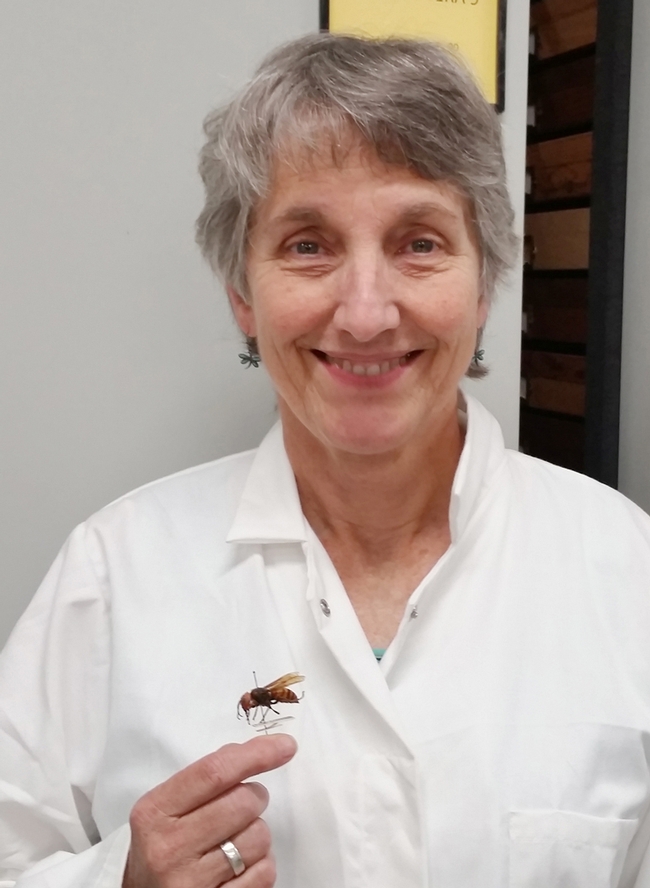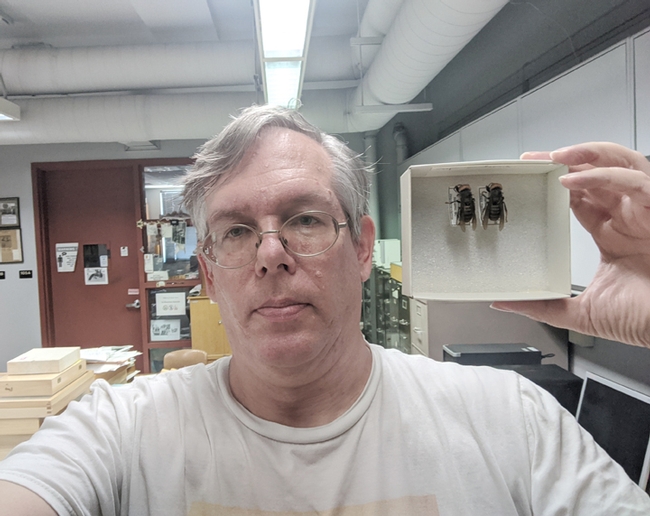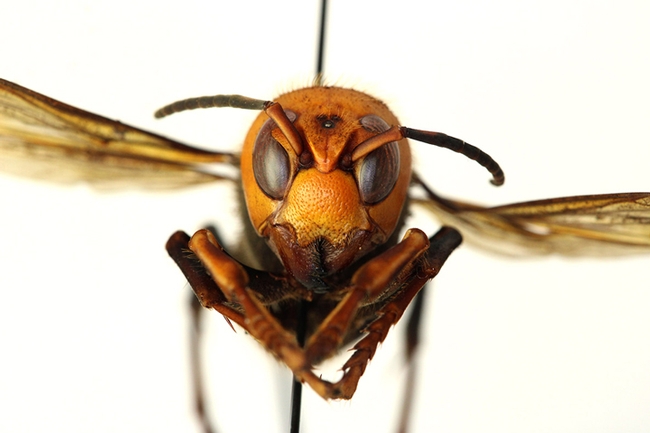
And well they should.
UC Davis wasp expert and researcher Lynn Kimsey, director of the Bohart Museum of Entomology and professor of entomology, UC Davis Department of Entomology and Nematology, called the name "ridiculous" and said "it's no more likely to sting and kill a human than a honey bee." (See Bug Squad blog)
Kimsey, a two-term past president of the International Society of Hymenopterists, told us yesterday that “Actually it's less likely, as honey bee venom packs quite a punch and it is exclusively designed to defend against vertebrates."
“The colony everyone is hyperventilating over was actually found on Vancouver Island, British Columbia, last September when it was destroyed and then a single, dead hornet was found in December in Blaine, Wash.,” Kimsey said. “There is no evidence that there are any more hornets in the vicinity of Vancouver or anywhere else on the West Coast.”
A colony of the Asian giant hornet (AGH), Vespa mandarinia, was found and destroyed Sept. 18, 2019 in Nanaimo, Vancouver Island, and the single dead hornet was found Dec. 8, 2019 in Blaine.
These were the first detections of this species in North America, and no, the so-called "murder hornets" are not out to get us. They're not out to kill you. They're not taking over the world. (Expect some upcoming horror movies, though!)
Twenty Asian giant hornet (AGH) specimens are housed in the Bohart Museum of Entomology, home of a global collection of nearly 8 million species. The largest AGH, a queen, measures about an inch and a half long, Kimsey said. She's never seen any larger than that.
Meanwhile, entomologists are bemoaning the name, "murder hornet" and the sensationalism and fear-mongering ensuing. Apparently the name originated with a Japanese researcher; out of the translation came "murder hornet."
“It's a bloody dumpster fire,” said entomology advocate, traveler and photographer Stephane De Greef, administrator of a newly created Facebook page, “Is This a Murder Hornet?”
“Some poorly-worded media reports about Asian giant hornets have triggered a veritable avalanche of nonsense online, but I can help set the record straight, wrote senior museum scientist and hymenopterist Douglas Yanega of UC Riverside Entomology Research Museum.
“One colony was found and exterminated in Nanaimo on Vancouver Island in September of 2019, with a few sightings associated,” Yanega wrote. “One wasp believed to be from that colony was found--dead--on the U.S. side of the border near Nanaimo in December. Right now, all the authorities are doing is asking people to keep their eyes peeled JUST IN CASE there were queens that escaped the destruction of the Nanaimo nest, and established their own nests nearby. I was one of the authorities brought in to consult on this case, and to my knowledge there have not been any sightings in 2020 that would suggest the eradication attempt was unsuccessful. Put bluntly, as far as we know, there are no Asian giant hornets alive in either the U.S. or Canada as of 2020, and if there are, then they would be in the immediate vicinity of Vancouver Island (about a 50 mile radius or so).”
Want to know more about them? Read the fact sheet published by Washington State University Extension. It's the work of the husband-wife team of Susan Cobey, bee breeder-geneticist and Timothy Lawrence, county director of Island County Extension (both formerly of UC Davis), and also Mike Jensen, county director of Pend Oreille. (See https://bit.ly/2SA3TxS)
“It is critical that we identify, trap, and attempt to eliminate this new pest before it becomes established and widespread,” they wrote. “Attempts to contain the spread and eradication of this invasive insect will be most effective in trapping queens during early spring before their nests become established. Finding the nests can be a bit of a challenge. Their nests are typically in the ground though they can also be found under overhangs and within wall voids. The AGH is a strong flier and often will fly up and away and have an extensive flight range. Thus tracking can be difficult.”
They advise residents to “proceed with extreme caution and contact WSDA immediately. Do not try to exterminate the nest yourself.”
The sensationalism on the media is a concern, said Lawrence, "but...we need to find out just how extensive this infestation is."
Facebook users are posting images of so-called Asian giant hornets that are actually such species as cicada killers, European hornets, southern yellow jacket queens, sawflies, hoverflies, a beetle, and even a moth.
“Yes, it is possible this species could establish,” wrote Sloan Tomlinson, a parasitoid wasp specialist and educator. “Has it yet? No. Until concrete evidence is presented about any further establishment by this species, it's simply conjecture. Additionally, even IF this species is established, their infamy is overhyped and sensationalized. In Japan they do indeed kill around 30 people a year. Around 40 people are killed annually in the US by domestic dogs.”
Doctoral candidate and researcher Ellie Field of Iowa State University wrote on Facebook that “the murder hornet articles are making the rounds quickly and they seem to be doing more harm than good. Yes, it is awesome to track insect populations (particularly staying watchful for non-native and potentially invasive species). But no, the Asian giant hornet (Vespa mandarinia) is not going to destroy America. The one nest and individual that was found around Vancouver last year was destroyed, and this doesn't indicate any establishment. Introduction events happen all the time, all across the world! That region should continue to keep a watchful eye, but for everyone else this is not going to be relevant. There is no invasion, just a small possibility that some may have overwintered in that area.”
Those unsure about insect identification can email an image to Lynn Kimsey at lskimsey@ucdavis.edu or contact the Entomological Society of America at https://www.entsoc.org/ or https://bit.ly/2W2jRmi.
Entomologists also identify insects on such Facebook pages as “Insect Identification,” “Entomology,” and “Spider and Insect Enthusiast.”
Meanwhile, they're trying to douse the "bloody dumpster fires."
(Update: UC Davis distinguished professor Walter Leal, who studied and worked in Japan, asked a Japanese friend today about the origin of "murder hornet": The Asian giant hornet, Vespa mandarinia, is called “Kiiro Suzume Bachi (????????)” in Japanese. It injects its venoms, sometimes inducing severe anaphylaxis. The article in BBC introduced Asian giant hornet, Vespa mandarinia as “murder hornet” is at https://www.bbc.com/news/52533
Attached Images:

Entomologist Doug Yanega of UC Riverside shows two Asian giant hornets, one of which is from the colony detected and killed on Vancouver Island, British Columbia. He was sought out to identify the species.

This image of an Asian giant hornet, Vespa mandarina, is courtesy of the Washington State Department of Agriculture. The beekeeping industry is concerned about sightings, confirmed and unconfirmed, of this insect in British Columbia and Washington state.